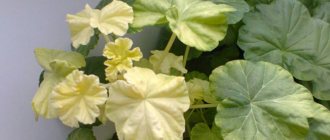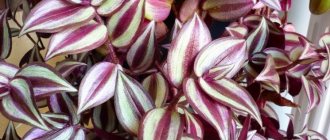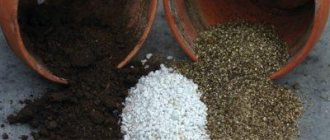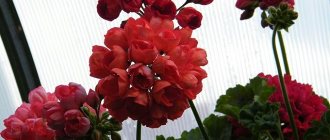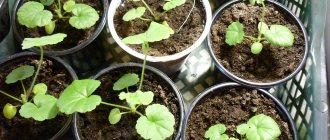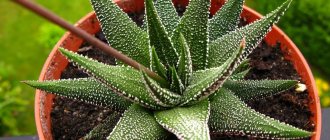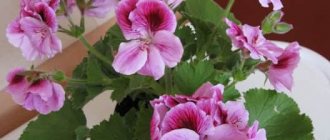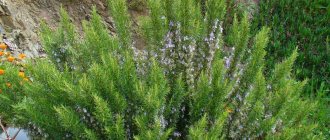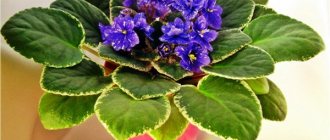In fact, the correct name for this popular houseplant is Pelargonium, but among the people the name “geranium” is firmly attached to it.
True geraniums also exist in nature, many species grow wild in Russia - they can be found in meadows and forests. Both genera belong to the Geraniaceae family, are similar in appearance, and even their names have similar meanings: the word “pelargonium” comes from the Greek “pelargos” - “stork”, and “geranium” is derived from the Greek “geranos” - “crane” . And cranes and storks, as is known, also have external similarities, for example, a beak - it was this that gave the names to the two plants, because their fruit-boxes have an elongated shape and resemble a bird’s beak.
In general, there are many similarities between pelargonium and geranium, but they are still different plants. However, let’s not be boring, and let’s pay tribute to folk traditions - let this home flower be a geranium.
Types and varieties of geraniums (pelargoniums)
There are 280 species of pelargonium in the world (1), but only a few are used in indoor culture.
zonale . She is bordered pelargonium. This type is most often found in apartments. It got its name due to the color of the leaves - they have a darker, often brown stripe along the edge. The leaves are pubescent, with a strong odor. The flowers are collected in large umbrella inflorescences.
Pelargonium is zonal. Photo: pixabay.com
This pelargonium comes from South Africa. It came to Europe at the end of the 17th century and was very popular there for a long time. And so much so that at some point it became a symbol of bourgeois tastelessness. This plant reached Russia only a century later - at the turn of the 18th - 19th centuries. And at first, the beautiful geranium grew exclusively in aristocratic houses. But later everyone began to grow it without exception.
Currently, this pelargonium has more than 10,000 varieties. According to the modern classification proposed by the owner of the English national collection of pelargoniums Fibrex Hasel Kay, zonal pelargoniums are divided into several groups:
- non-double - they have simple flowers with 5 petals arranged in 1 row;
- terry - this includes semi-double varieties with 6 - 8 petals, terry, which have more than 8 petals, as well as tulip-shaped, in which the flowers are semi-double, but they never open - they remain in buds, reminiscent of tulip buds;
- Rosaceae (rosaceae) - with densely double flowers, similar to half-open roses;
- star-shaped (stellar) - their flowers are shaped like stars;
- cactus-shaped - their flowers have long petals, which are sometimes curled into a tube and resemble some cactus flowers;
- variegated (variegated) - they have variegated leaves of various shapes and colors;
- miniature - form very small bushes;
- dwarf - combines all low-growing varieties.
The most interesting and unusual varieties of zonal pelargonium:
- Appleblossom Rosebud - with densely double white, pink-shaped flowers with a pink border and a green center;
- Chelsea Morning - with large snow-white flowers, which have a bright crimson spot at the base of each petal;
- Deacon Peacock - with double orange-red flowers and green-gold foliage with a bronze edge;
- Doreen - with large double peach-pink flowers, which have a white border along the edge of the petals and dark pink veins in the center;
- Icecrystal - with pink-lilac flowers, which have a fuchsia-colored spot at the base of each petal;
- Golden Choice - with dense pink flowers and golden foliage with a red-brown border;
- Green and Gold Petit Pierre - a stunning variety with light green leaves, which has a green spot in the center, bright pink flowers with long petals;
- Joy - with large double flowers of a very unusual color - they are creamy white with a soft pink border along the edge of the petals;
- June Patricia - star-shaped pelargonium with double flowers of orange-red color, with golden leaves;
- Plum Rambler - with densely double flowers of a rose-shaped dark red color with a white underside at the petals.
Ivy-leaved pelargonium (Pelargonium peltatum). Another popular pelargonium and also native to South Africa. People often call it ampelous geranium. It is a trailing plant, but when planted in a hanging pot, it hangs over the edges impressively. The leaves of this pelargonium are glossy, the flowers are collected in umbrella inflorescences and can be of a wide variety of colors.
Pelargonium ivy-leaved. Photo: A. Jagel, globallookpress.com
Among the varieties, the most spectacular ones can be identified:
- Great Balls of Fire Violet Blue - with large semi-double flowers of rich lilac color with crimson veins in the center;
- Great Balls of Fire Merlot - with huge caps of double, rich cherry flowers;
- Temprano Orchid - with double salmon-colored flowers.
Large-flowered pelargonium (Pelargonium grandiflorum). Flower growers often call it the royal geranium. This is one of the most spectacular species - the inflorescences can reach a diameter of 15 cm, and the flowers bloom almost continuously from May to October. They have a variety of colors, there are two-color varieties. This pelargonium also comes from South Africa.
Pelargonium grandiflora. Photo: pixabay.com
She has interesting variety series. For example, Angel are hybrids obtained from crossing large-flowered pelargonium and curly pelargonium (Pelargonium crispum). Their flowers resemble those of violets or bright butterflies. And the leaves smell like lemon. Here are the most popular ones:
- Angel Tip Top Duet - 30 - 40 cm high, the upper petals of the flowers are dark crimson with burgundy veins, the lower ones are pale lilac;
- Angeleyes Bicolor - two-color color: the upper petals are crimson and the lower petals are white;
- Angeleyes Angel Mosquitaway lizzy - with white flowers and a burgundy spot in the center, leaves with a strong lemon aroma.
- Angeleyes Angel Randy - up to 40 cm high with small flowers, up to 2 cm in diameter, light pink in color with a crimson spot and a white edging along the edge of the petals, with a slight aroma of the leaves;
- Wayward Angel - with light lilac flowers with crimson spots on the upper petals.
Another popular variety series is Aristo. It was bred in Germany and is distinguished by its compact bush size and large inflorescences that bloom for 3 months in a row. The most popular varieties:
- Aristo Black Beauty - with burgundy-purple flowers;
- Aristo Candy - the upper petals are purple with a lilac border, the lower petals are lavender with fuchsia spots;
- Aristo Petticoat - lower petals are pure white, upper petals are white with a bright burgundy spot.
Pelargonium grandiflora has several more interesting varieties that are also worth paying attention to:
- Birthday Gir - bright pink flowers with a white base and ruffled edges of the petals;
- Fairy Queen - with large flowers: the upper ones are dark purple with a white edge, the lower ones are white with purple spots and streaks;
- Mona Lisa - with large white and pink flowers and a crimson spot at the base of the petals.
Pelargonium fragrant.
Photo: F. Hecker, globallookpress.com graveolens . This is the same “grandmother’s flower” that grew on the windows of many apartments in Soviet times. Its flowers are not as spectacular as those of other species, but it is not valued for them either. The leaves are what attracts gardeners. They are carved, velvety and very aromatic - with a distinct hint of lemon.
Types of pelargonium
- Pelargonium zonal
- Pelargonium royal
- Pelargonium angel
- Pelargonium ivy or ampelous
- Pelargonium fragrant
Pelargonium zonalis gets its name because of the colored zones on the leaves. Please note that these colored rings resemble balls. This is exactly what our grandmothers called their pelargoniums or “geraniums”. Colored stripes - zones can be pronounced or less pronounced, I noticed that this depends on the type of flower, light and temperature.
Royal or domestic pelargonium is distinguished by large luxurious flowers with a small stem height.
Angel pelargoniums are similar to miniature royal pelargoniums with the same beautiful flowers, but in miniature, and the plant itself looks more compact.
Ivy-leaved pelargoniums, also known as ampelous ones, actually resemble ivy in the shape of their leaves. The flowers are single or double on long stalks, which is why they give the impression of a huge hat on a small plant. They withstand wind and rain surprisingly well.
Fragrant pelargonium is valued not so much for its flowers as for its fragrant foliage, from which essential oil is obtained.
Pelargonium or geranium, I know the difference, but this does not stop me from calling my flowers the way my mother, grandmother and great-grandmother called them. There is so much tenderness in this phrase - my geraniums, isn’t it?
For pelargonium to bloom magnificently, read here on the website
Autumn and spring pruning of geraniums for lush flowering
Care for geraniums at home
In general, geraniums can be considered unpretentious, but they have a number of requirements that are important to consider. Grandiflora pelargonium especially likes to show off.
Priming
Any universal soil for flowering plants will do. But it's better to cook it yourself. The ideal option is a mixture of turf, leaf soil and humus in a ratio of 1:1:1 (2).
Temperature
In summer, pelargoniums need to be kept very warm - up to 27 °C, and in winter it should be low - about 14 °C.
It should be remembered that pelargonium does not like cold drafts. Therefore, when ventilating the room, leave the flower away from the open transom. In general, the flower is very loyal to ventilation.
Photo: B. Rainer, globallookpress.com
Lighting
All types of geraniums love plenty of sunlight, so they need to be placed on a well-lit windowsill, periodically turning the pot so that the bush is formed even and regular.
In winter, it is necessary to supplement the geranium with special phytolamps, otherwise the flower may wither. Geraniums need at least 12 hours of full daylight so that the shoots do not stretch.
Humidity
Pelargoniums do not like being flooded, because they come from Africa, and there are often droughts there. Therefore, it is necessary to water moderately; the soil in the pot should dry completely between waterings. In summer, watering should be more abundant - without water, the leaves will fade and the flowers will begin to fly off. But do not allow water to stagnate in the tray; geraniums do not need excess moisture.
They are undemanding to air humidity, but respond well if they are sprayed with soft filtered water from time to time (especially in winter, when batteries dry the air) (so that white stains do not remain on the leaves).
Fertilizers and fertilizers
You can feed geranium much less often than other flowers - once every 2-3 weeks in summer, once every 2-3 months in winter. Fertilizers can be chosen universal or for flowering plants.
Trimming
In the fall, after the geranium has faded, you need to slightly shorten the crown. If this is not done, the geranium will grow into a shapeless bush. Flower growers note: the more you prune geraniums in the fall, the more magnificent they will be in the spring.
And be sure to remove dry leaves and inflorescences.
History of a flower
As already mentioned, geranium originally grew in South Africa. But, often, sailors who visited various places were interested not only in culture, infrastructure, but also in the plants that appear in a particular area. Therefore, a flower like geranium could not go unnoticed. Naturalists drew attention to the amazing inflorescence that they contemplated in such a warm climate. After this, they had a desire to adapt the plant to new living conditions. This is how geranium began to spread to different parts of the world, adapting to the varied climates in which it found itself. Because of this, people are now surprised by the fact that the birthplace of geranium is a country where the weather is hot almost all year round.
The flower reached Russia somewhere in the 18th-19th century. Some types of geraniums were left to grow in the wild, while they tolerated cold weather. But many varieties of plants began to decorate people's rooms.
As a result, geranium was developed by breeders who began to breed different varieties. Each plant has a difference in color and shape. But even in its homeland, geranium continues to please the eye; it looks the same as a houseplant.
Propagating geraniums at home
Green cuttings. Do not throw away the cut tops of geraniums - this is an excellent material for flower propagation. However, cuttings cut in winter most likely will not take root, but those taken in the fall may take root. In general, there are 2 optimal times for cuttings: March and August (3).
Such “crown” plants retain all the properties of the mother plant and begin to bloom in the first summer after rooting. Cuttings usually take root in 2–3 weeks.
Seeds. Geranium is also propagated by seeds, but this is a much more labor-intensive and less effective method. It is better to sow seeds in plastic containers - they are laid out on the surface of the soil without covering them with soil and covered with a lid.
The germination of seeds depends on the initial quality, and this is always a lottery. After the sprouts appear, open the lid and place the container in a well-lit place, water more often, but do not overfill. Additional illumination with phytolamps is a must! Plants from seeds usually bloom within a year.
How to distinguish geranium from pelargonium?
Geranium has flowers consisting of 5 or 8 petals. They are usually solitary, only occasionally collected in inflorescences. differs in the corolla of the flower. It has an irregular shape - the two upper petals are slightly larger, the three lower petals are smaller. Pelargonium flowers form large inflorescences. Geranium can be painted in a variety of colors (except scarlet). Pelargonium never has blue shades.
Geranium is a garden plant. Summer residents love him very much. Particularly popular are varieties such as “magnificent”, “Georgian”, “Oxford”. Pelargonium blooms at home throughout the year. In summer it can be taken out to the balcony or into the garden, but with the onset of cold weather you should bring the plant into the house.
Transplanting geraniums at home
Photo: Helmut Meyer zur Capellen, globallookpress.com
It is not worth replanting geraniums often, it is stressful for them. There are 2 signs when a flower needs replanting:
- the roots were exposed;
- the geranium began to wither and wither (perhaps it was overwatered, the roots began to rot, so when replanting they will need to be treated with potassium permanganate and dried a little);
Transplant the flower into a pot that is slightly larger than the previous one, carefully transferring it along with a lump of earth. Drainage is a must!
Pelargonium or geranium - what's the difference?
Photo of geranium
Geranium
Photo of pelargonium
Pelargonium
Judging by the photo, the differences between the sisters are so great that the question of what is the difference between representatives of the same family turns into the area of differences in care and use.
Diseases and pests of geranium
There are several classic problems that arise when growing geraniums.
Gray rot appears on the stems and leaves. Typically, the cause of this problem is overflow.
It is best to remove the flower from the pot, dry the roots, treat them with potassium permanganate and plant the plant in a new pot with fresh soil.
The roots rot close to the ground. This is root rot.
Alas, the plant cannot be saved; it will have to be thrown away.
A whitish coating appears on the leaves. Most likely it is powdery mildew.
For treatment, you can use Fundazol (4) or biological products: Fitosporin-M, Alirin-B, Gamair, Pseudobacterin-2, Planriz.
The leaves curl into a tube, turn yellow and fall off. Examine the reverse side - these could be whiteflies or aphids.
To control pests, you can use the drug Actellik (4).
Types of geraniums
The magnificent perennial garden geranium actually has a magnificent lilac color and prefers sun and partial shade.
Gorgeous garden geranium
Dark brown geranium (Geranium Phaeum) - partial shade, shade
Geranium dark brown
Oxford geranium - partial shade, shade. Captures space quickly.
Geranium oxford
Blood red geranium - partial shade.
Blood red geranium
Meadow geranium
Meadow geranium
Popular questions and answers
agronomist-breeder Svetlana Mikhailova about growing pelargoniums and the problems that may arise
Is it possible to grow geraniums in open ground?
Pelargoniums are heat-loving plants; in winter they can only be grown at home. But in the summer it is not only possible, but also necessary to replant them in the garden - there are the most optimal conditions for them. They need to be planted when the threat of spring frosts has passed - after June 10. And in early September, the plants should be dug up, planted in pots and brought into the house.
Why do geranium leaves turn yellow?
Most likely the reason is insufficient watering. In summer, when it’s hot, geraniums need to be watered once every 2–3 days, but make sure that the lump of earth dries out completely. And it is also important that the water in the pot does not stagnate - this leads to rotting of the roots.
Why don't geraniums bloom?
Most likely the roots are too free - geranium blooms profusely when the roots have completely entwined the soil. If there are no flowers, transplant the geranium into a smaller pot.
Sources
- Pelargonium // Royal Botanic Gardens Kew https://powo.science.kew.org/taxon/urn:lsid:ipni.org:names:30302759-2#children
- Visyashcheva L.V., Sokolova T.A. Industrial floriculture. Textbook for technical schools // M.: Agropromizdat, 1991 – 368 p.
- Tulintsev V.G. Floriculture with the basics of selection and seed production // Stroyizdat, Leningrad branch, 1977 - 208 p.
- State catalog of pesticides and agrochemicals approved for use on the territory of the Russian Federation as of July 6, 2022 // Ministry of Agriculture of the Russian Federation https://mcx.gov.ru/ministry/departments/departament-rastenievodstva-mekhanizatsii-khimizatsii- i-zashchity-rasteniy/industry-information/info-gosudarstvennaya-usluga-po-gosudarstvennoy-registratsii-pestitsidov-i-agrokhimikatov/
What is the difference in care between geranium and pelargonium
Garden geraniums are perennial plants.
- In winter, they do not need to be dug up or covered; they will overwinter wonderfully. At the end of the season or early spring, you will need to remove the wilted dried geranium greens; this is done once a year.
- Planted in soil with good water permeability. Planted in small groups. Geranium is a ground cover plant; it spreads well, and sometimes even too well, over an area and can cover large areas of land in a short time.
- They do not need fertilizing.
- Willingly settles in shade, partial shade and feels good in dry shade.
- Has a strong branched root system
Pelargonium is a completely different person to care for. This heat-loving child of the south grows outdoors as an annual.
- For the winter, it is either dug up and transferred to boxes for cool winter storage or thrown away. Pelargoniums are stored at a temperature of 5-7 degrees with limited light and sometimes moistening the soil.
- Flowering requires light. Zonal pelargonium grows and blooms well on balconies with a semi-shady location, when there is shade for less than half the day and sun the rest of the time.
- Needs regular feeding and moderate watering.
- It has a small fibrous root.
Comparison
In nature, plants exist in different conditions. Geraniums are native to the soils and climate of the Northern Hemisphere. This is what can be found in meadows among other grass. The difference between geranium and pelargonium is that it feels great even at low temperatures. As a beautiful flower, geranium is grown in gardens without needing shelter for the winter.
Pelargonium is a flower sensitive to cold. After all, its natural conditions are African savannas. Therefore, pelargonium, which has sufficient decorative value, is used to decorate the interior. It can also be placed on summer verandas. But wintering in the open ground is completely contraindicated for it.
There are also external differences between plants. They concern mainly the flowers themselves. In geraniums they are in most cases solitary. Five, rarely eight, petals of such a flower are collected in the correct order and do not differ from each other in shape, size and color. Geranium has ten developed fertile stamens.
As for pelargonium, its flowers are most often combined into spectacular large inflorescences. In many species of this plant, there is an asymmetry in the arrangement of the petals, when the top two of them are separated from the rest. In this case, the flower turns out incorrect.
Pelargonium has no more than seven fertile stamens, the rest are underdeveloped.
Let's look at the difference between geranium and pelargonium when we compare the color of their flowers. In this regard, it is worth noting that geraniums correspond mainly to blue and purple colors, as well as shades close to them. In addition, garden varieties with pink, crimson and pure white flowers have been bred. But scarlet geranium does not exist.
Meanwhile, it is impossible to find blue pelargonium, since this color is absolutely not characteristic of it. Traditional color options in this case will be soft pink, red, white. Two-color varieties and those where the petals are marked with spots and contrasting strokes are also interesting.
Many gardeners are confident that they grow geraniums on their windowsills. However, only a few people know that the houseplant is called pelargonium (and this is not the same thing). In this article we will tell you how geranium differs from pelargonium.
Although geranium and pelargonium are not usually distinguished, from a scientific point of view, they are completely different plants. How did it happen that people believed that two different flowers were the same thing? The fact is that in the 18th century, the scientist Carl Linnaeus, while developing his classification of plants, mistakenly classified both of these flowers as one species, and it was his classification that flower growers accepted. But another scientist, who presented his classification around the same time, came to the conclusion that pelargonium and geranium are not the same thing, and it was this approach that appealed to the scientific community. Thus, some people mistakenly call a plant with a completely different name geranium.
So, the scientific name of geranium is Geranium, and those flowers that are usually grown indoors are called Pelargonium. These plants not only have a different name, they even differ in appearance, since they belong to different biological species.
LiveInternetLiveInternet
Home flowers, Beautifully flowering/indoor.usadbaonline.ru/themes/publication_4/theme_3/_img/hredbg.gif" target="_blank">https://indoor.usadbaonline.ru/themes/publication_4/theme_3/_img/hredbg.gif);
background-repeat: repeat-x;»> Pelargonium and geranium are different plants
Author: Zinaida Petrova
Many flower growers believe that geranium and pelargonium are the names of the same plant. But is this really so?
Luxurious geranium bushes have been popular among gardeners for a long time. However, botanists insist that the name of the plant we grow in windows is pelargonium, and it is very different from real geranium. Are they right? Let's figure it out.
Why the confusion?
Discrepancies began in the middle of the 18th century. When compiling a classification of plants in 1738, the Dutch botanist Johannes Burman proposed separating geranium and pelargonium into separate genera. Contrary to his opinion, the Swedish natural scientist Carl Linnaeus, who compiled his classification, united them into one general group. It was at this time that pelargonium was at the peak of its popularity and was actively used in landscape gardening in Victorian gardens. Flower growers recognized it as “geranium”, and this name was firmly attached to it.
Common features of geranium and pelargonium
The similarity between these two plants is that they belong to the Geranium family. There are 5 genera and 800 species in this family. The largest genus is geranium, the most famous is pelargonium. They were combined into one family because of their original fruit capsule. After pollination, the pistil column elongates disproportionately and takes on a special shape: in the form of the head and beak of a crane. It is no coincidence that in translation from Greek “Pelargos” means stork, and “Geranium” means crane. The similarity between geranium and pelargonium also lies in the erect stems, the leaves on which are arranged alternately or oppositely and are covered with small glandular hairs. Often, many Geraniums have a special smell. These plants are unpretentious, tenacious, easy to reproduce and love the sun.
Differences between geranium and pelargonium
Geranium and pelargonium are different plants. They cannot be crossed with each other because they will not produce seeds: this is due to different genetic characteristics. Geranium is a plant of the Northern Hemisphere, pelargonium comes from the southern regions: the Cape Province of South Africa, Australia, Syria, tropical Africa. Geranium is a frost-resistant plant and can bloom at 12°C, while the southern sissy pelargonium overwinters only in greenhouse conditions.
You can distinguish geranium and pelargonium by their external characteristics.
Geranium flowers consist of 5 or 8 petals, solitary or sometimes collected in inflorescences. In pelargonium, the corolla has an irregular shape: the upper two petals are slightly larger, the lower three are smaller. Characteristic of large inflorescences are umbels.
/indoor.usadbaonline.ru/themes/publication_4/theme_3/_img/black-dot.png" target="_blank">https://indoor.usadbaonline.ru/themes/publication_4/theme_3/_img/black-dot.png ) repeat;»>
On the left - geranium, on the right - pelargonium
Geraniums are found in various shades of the flower, except scarlet. Pelargonium does not have a blue range.
/indoor.usadbaonline.ru/themes/publication_4/theme_3/_img/black-dot.png" target="_blank">https://indoor.usadbaonline.ru/themes/publication_4/theme_3/_img/black-dot.png ) repeat;»> Left - geranium, right - pelargonium
Geranium is a garden plant. She spends the winter without shelter. In recent years, gardeners have seen a demand for geraniums. Such spectacular varieties as magnificent geranium, Oxford geranium, and Georgian geranium are good. Pelargonium at home can bloom all year round. In the summer it can be planted in open ground, but be sure to move it indoors with the onset of cold weather. The plant does not tolerate winter temperatures.
/indoor.usadbaonline.ru/themes/publication_4/theme_3/_img/black-dot.png" target="_blank">https://indoor.usadbaonline.ru/themes/publication_4/theme_3/_img/black-dot.png ) repeat;»> Left - geranium, right - pelargonium
Conclusion
Unpretentiousness, long flowering, large bright inflorescences make pelargonium a favorite among indoor plants. And modest geranium can be found in summer meadows, forest edges, and, more recently, in gardens.
/indoor.usadbaonline.ru/themes/publication_4/theme_3/_img/hredbg.gif" target="_blank">https://indoor.usadbaonline.ru/themes/publication_4/theme_3/_img/hredbg.gif); background-repeat: repeat-x;»> Types of pelargoniums - which one to choose
Author: Olga Orlovskaya
In fact, choosing pelargonium is not so easy. The variety of hybrid varieties bred by breeders impresses even a gardener who is indifferent to these plants.
Almost all pelargoniums, and there are more than 250 species, come from South Africa. They are united according to decorative characteristics into five main groups: large-flowered, fragrant, ivy-leaved, succulent and zonal. When choosing, you need to proceed from where you are going to grow pelargonium: on a window, balcony, in a greenhouse or on the street.
Zonal pelargoniums
This group got its name because of the strip that runs at some distance from the edge and divides the leaf plate into areas of different shades. Zonal pelargonium blooms profusely and for a long time, and also has a variety of petal colors: white, pink, lilac, red. Standard forms can reach 1.5 m in height, and dwarf varieties do not exceed 20 cm.
There are several subgroups of zonal pelargoniums: flower bed, greenhouse, decorative leaf. The first subgroup grows well both indoors and outdoors. The shape of the flowers is double, semi-double, simple, star-shaped and cactus. Representatives of the second subgroup do not grow in the open air. A subgroup of decorative pelargoniums have an unusual leaf color: a reddish-brown border on green (or vice versa). Hybrids with white-green and golden-peach leaves are very decorative.
Ivy-leaved pelargoniums
Representatives of this group belong to ampelous plants. The leaves of ivy-leaved pelargoniums are dense, dark green, and glossy. Flowers are double, semi-double and simple. The inflorescences are collected in brushes, the color of the petals is varied. The most decorative varieties are those with leaves outlined by a light border.
Fragrant pelargoniums
The main criterion for choosing fragrant pelargonium is the smell of its leaves. Varieties with aromas of rose, mint, lemon, orange, apple, nutmeg, ginger, apricot, cinnamon, and verbena have been developed. The bush reaches a height of 90 cm and even more. The leaves are not only fragrant, but also decorative: some are deeply cut, others have a thick frill along the edge. Umbrella-shaped inflorescences. Petal color: white, red, pink and even purple.
Large-flowered pelargoniums
A very decorative and luxurious group of pelargoniums. No wonder it is also called royal. Compared to other species, this pelargonium is very difficult to care for. The bush grows up to 60 cm. The leaves are small with a serrated edge. The flowers are large, corrugated, up to 5 cm. The color of the petals can be white, salmon, lilac, burgundy, red. Very impressive are the varieties obtained by crossing large-flowered and curly fragrant pelargoniums - violiferous. They bloom for a long time, and the leaves have a pleasant aroma.
Succulent pelargoniums
Succulent pelargoniums
This group of plants is popular only among those enthusiastic gardeners who are not afraid of the difficulties of agricultural technology. There are only a few types of succulent pelargoniums: humpbacked, cortus-leaved, fleshy, alternate, fluffy-leaved, thick-stemmed, angular. There are species with spines. Due to the ability of the stem to twist, succulent varieties are used to produce bonsai.
/indoor.usadbaonline.ru/themes/publication_4/theme_3/_img/hredbg.gif" target="_blank">https://indoor.usadbaonline.ru/themes/publication_4/theme_3/_img/hredbg.gif);
background-repeat: repeat-x;»> Pelargonium: secrets of healthy growth
One of the popular plants that can be grown both at home and in the garden is pelargonium. What are the main points of caring for different types of this flower?
Zonal pelargoniums. This group is the most loved and widespread. Zonal pelargoniums are very different from each other. Simple zonal and star-shaped ones have 5 petals each. Terry flowers have more than 5, they bloom very readily and their petals do not fall off.
Rosebuds are very double, similar to roses.
Tulip-shaped - flowers resemble an unopened tulip.
Star-shaped - with star-shaped leaves and flowers.
Variegated - multi-colored leaves.
Ivy-leaved pelargoniums. They have leaves like ivy with a long stem. Grow in hanging baskets and balcony boxes. Flowers of various colors, double, semi-double and single.
Royal pelargoniums (royal or domestic) are bush plants with very large flowers, double or simple.
Pelargoniums with fragrant leaves can smell like lemon, rose, apple, pineapple, spices and even cologne.
Unicum pelargoniums are relatives of the royal ones, with a spicy scent and decorative caps of inflorescences, and are not afraid of rain.
"Angels", or violet pelargoniums with flowers similar to pansies, bloom all summer, forming luxurious "caps".
Preparing for winter
A difficult and responsible moment is to preserve plants in winter. We offer several options for their winter maintenance. If the room temperature does not drop below 20°C, place the pelargonium in a bright place and water it moderately. At the end of August, take cuttings from plants that have bloomed, root them and keep them in winter in normal indoor conditions, on window sills or shelves with additional lighting. In this case, the mother plants can be discarded.
If the flower grew in open ground, dig it up in the fall, cut it in half, plant it in a pot and bring it into the house, place it on a windowsill or shelf with additional lighting. The main thing is not to place it close to heating devices and radiators.
You can dig up the plant, shake off the soil from the roots and hang it in the basement. But at the same time, it will be well preserved in conditions of high humidity (85-90%) and at a temperature not higher than 10-12°C.
Trimming
Without it, plants become frail and ugly, the flowers fade and become smaller. In early spring, before growth begins, cut the stems to 1/3 of the length with a sharp knife, and remove weak shoots completely. Sprinkle the cutting area with crushed coal or treat it with brilliant green. The pruned plant produces new shoots with young leaves.
How to properly root pelargonium cuttings
- Do not water the mother bushes for 3-4 days, then cut the cuttings from them and dry them until the evening.
- Place in water with a growth stimulator dissolved in it.
- When the roots appear, plant them in the soil under the jar.
On a note
Varieties with white areas on the leaf blade require very good lighting. They grow much more slowly than their green-leafed counterparts. In direct sun, the edges of the leaves may dry out.
- Do not cover the cuttings with a bag: excess moisture can cause them to rot.
- If the planted cuttings have wilted, you can put it in water until the turgor of the leaves is restored, then plant it in the ground again. “Pestrolistki” take root better in early spring on a well-lit windowsill (but not in direct sunlight!).
- Pelargoniums should not be fed with organic fertilizers. Nitrogen fertilizers are also not used. Preparations containing microelements are quite sufficient. But for flowering, phosphorus-potassium fertilizers are simply necessary.
/indoor.usadbaonline.ru/themes/publication_4/theme_3/_img/hredbg.gif" target="_blank">https://indoor.usadbaonline.ru/themes/publication_4/theme_3/_img/hredbg.gif); background-repeat: repeat-x;»> Features of caring for pelargonium
Author: Tatyana Bobrovskaya
Royal pelargonium received its name for a reason. In its beauty it can easily compete with the azalea. In order for the plant to be healthy and bloom luxuriantly, it is necessary to follow some rules for its maintenance.
The beauty comes from South-West Africa and is adapted to a climate with strict precipitation periods: dry summers and wetter winters. Therefore, in our conditions it needs a rest period of 2.5-3 months.
Temperature and watering
In winter, it is advisable to lower the temperature and sharply reduce watering. When wintering in a warm room, in low light conditions, the shoots stretch, the leaves turn yellow and dry out, and the plant weakens. Then it takes a long time to gain strength and does not bloom. My pelargoniums overwinter at temperatures of 3-10°C. A decrease to 0°C (or more) leads to plant damage and death. The optimal temperature is considered to be 8-12°C.
There is no need for additional illumination of an adult specimen - this is a short-day plant. I don’t let the soil dry out completely; I periodically moisten the top layer. But overwatering is completely unacceptable.
With the arrival of spring, I increase watering. At the same time, the intensity of illumination also increases. Without bright sunlight in the summer, you cannot count on abundant flowering (if there is a lack of light, it may not occur at all). However, too much solar activity (bright direct sun during the midday hours) can cause yellowing of the leaves and drying out of their edges. Overheating of the root system is also undesirable.
For pelargonium, the rule is: it is better to underfill than to overfill. The soil in the pot should dry out a little before the next watering. Excessive drying can affect flowering.
Excessive watering causes fungal diseases of the plant. For example, it affects black leg (the root collar of a young plant turns black) or gray rot (the bases of the shoots become brown, and after a while they become covered with a gray coating). In these cases, cuttings from healthy shoots can help. I was unable to save the plant with fungicides.
Conditions for roots
I prepare the soil from turf, leaf soil, well-rotted humus and coarse sand (it’s good to use perlite or vermiculite) in a ratio of 1:2:0.5:2. In any case, it should not be too nutritious. For abundant flowering, you can add a little bone meal to the soil. There is drainage at the bottom of the pot.
I take a medium-sized pot (12x12 cm), since in a small one it is difficult to maintain optimal substrate moisture. The size of the pot should be increased as the plant grows. Transplantation (transfer) is carried out every 2-3 years.
I feed the plants with complex fertilizers with microelements. It is better if the proportion of nitrogen in fertilizers is reduced and the amount of potassium and phosphorus is increased (fertilizers for flowering plants). It is not advisable to use organic matter. In August I stop feeding, as overfed specimens winter worse.
Cuttings and pruning
My plants practically do not branch on their own. And if you don’t prune, tall shoots grow that require garter. Pelargoniums bloom at the ends of the branches - there are few of them, and few inflorescences. I prune them after flowering. Flower buds of plants are formed in winter, so in February-March these pelargoniums are no longer pruned.
I propagate plants by cuttings in April. I cut the apical shoots 10-12 cm long, remove the lower leaves and buds. I make a cut along the semi-lignified part, wither it for 2-3 hours and plant it in a light, low-nutrient substrate (cuttings of homemade pelargonium practically do not take root in water). I water it moderately and don’t cover it.
Plants take root better if there is enough air in the soil. Therefore, I use a stick to make deep holes in the soil along the edge of the cup. Light needs to be bright and diffused. The duration of daylight is at least 12 hours (if necessary, I add fluorescent lamps). The optimal temperature is 18-20°C. Cuttings take about 3-4 weeks to take root. I carefully trim the yellowed and dried leaves with scissors, leaving part of the petiole.
/indoor.usadbaonline.ru/themes/publication_4/theme_3/_img/hredbg.gif" target="_blank">https://indoor.usadbaonline.ru/themes/publication_4/theme_3/_img/hredbg.gif); background-repeat: repeat-x;»> Royal Pelargonium
Author: Nadezhda Galynskaya
This plant is attractive because it has the most beautiful flowers of all representatives of the Geranium family. Although the flowering of pelargonium is short-lived, it is very impressive.
Pelargonium domestic (Pelargonium domesticum), or large-flowered, royal, royal, exhibition, English - a real queen among pelargoniums. Its flowers are distinguished by their large size, graceful color and shape. They come in simple, semi-double and terry. The petals are multi-colored and velvety. The leaves are pubescent, with serrated edges. In a series of Rosebud hybrids, the flowers look like small roses, and in others they even resemble orchids. The royal pelargonium of the Angels series is especially beautiful, with flowers that look like pansies.
Not everyone can make grandiflora pelargonium bloom. She loves the sun and warmth necessary for continuous and abundant flowering. Tolerates light shade, but blooms less luxuriantly.
It likes soil that is nutritious, but not too light. It can be made from equal parts of leaf or turf humus, peat and silt soil (from the river bank). You can add a little clay soil to the soil mixture. Such soil does not sour and retains moisture well. Silty soil can be replaced with compost.
Pelargonium suffers from drying out and does not tolerate waterlogging. However, it is better to underfill it than to overfill it. No need to spray.
Royal pelargonium is propagated by cuttings, usually at the end of summer and by seeds in February.
In winter, they are kept cool, but the temperature should not be lower than 12ºC.
/indoor.usadbaonline.ru/themes/publication_4/theme_3/_img/hredbg.gif" target="_blank">https://indoor.usadbaonline.ru/themes/publication_4/theme_3/_img/hredbg.gif); background-repeat: repeat-x;»> Collectible pelargoniums: care features
Author: Valentina KVITKINA
If you decide to have not ordinary pelargonium (popularly known as geranium), but a varietal one, or even a collection one, remember that they need especially careful care.
In my collection of pelargoniums there are zonal, ivy-leaved, and royal ones. I consider zonal pelargonium to be the easiest to care for. This plant is very light-loving; southern exposure is preferred in rooms, and unshaded areas in the front garden. I prepare the soil for it from leaf soil, humus and sand (2:2:1). I water abundantly in summer and moderately in winter. I propagate by cuttings and seeds.
Ivy-leaved pelargonium has creeping stems, leaves are dense, smooth and similar to ivy leaves, flowers on long peduncles are simple, double and semi-double. Blooms from April to October. I propagate ivy-leaved pelargoniums by cuttings and seeds. I dry the cut cuttings for 5-6 hours, then plant them in soil with added sand in a small pot. I don’t water the plants for two days after planting.
These pelargoniums love cool wintering, which is the key to abundant flowering.
But I give special preference to royal pelargoniums. They are more capricious, but the flowers are very beautiful and large, up to 8 cm in diameter, simple or double, plain or with spots, with a thin or wide border, sometimes with corrugated edges.
I cut the cuttings in spring and summer, dry them for 10-15 hours and plant them in a mixture of turf soil and sand (1:1), previously spilled with a dark solution of potassium permanganate. I don’t cover the cuttings and don’t water them for 2-4 days, I only spray them occasionally. After 3-4 weeks they take root.
I can’t take royal pelargoniums outside; they don’t like drafts and rain.
From October to February, I keep pelargoniums in a cool (from 7 to 12°C) but bright room. In early February, I replant it in fresh soil and move it to a warm, bright place.
I feed pelargoniums with fertilizers for flowering plants only during the flowering period.
https://indoor.usadbaonline.ru/ru/
orliya
Features of care
Pelargonium care
So, let's start with the pampered apartment dweller. First of all, it is worth saying that caring for her is not as difficult as it might seem at first glance, and anyone can cope with this task.
- It is important to water the flower regularly, but under no circumstances should it be flooded. It is best to maintain a golden mean. Watch when the top layer of soil dries out, and only then water.
- Lighting. It would be best to place the flower on the windowsill, where it will be well lit. A lack of light can cause the plant to either stop blooming altogether or have very small flowers. However, you should not place the pot in direct sunlight - the leaves may get sunburned.
- Trimming. It is necessary to regularly trim the flower, removing dried or broken stems.
- Also monitor the condition of the soil (it should be slightly loosened from time to time) and select a pot of suitable size for this beauty so that it can bloom luxuriantly.
Geranium care
It is customary to decorate your area with these lovely flowers. They are so unpretentious that neither sudden temperature changes nor even the proximity of weeds bother them.
REFERENCE!
The name geranium has Greek roots, Geranium (crane), and is due to the fact that the ripe fruits of the plant are shaped very much like the head and open beak of a crane. When ripe, the seed capsule of the fruit opens in an unusual way, splitting along its length from bottom to top.
| Type of geranium | Description | Varieties |
| Lesnaya | Bushy perennial plant up to 80 cm in height. The leaves are coarsely toothed and seven-parted. Numerous wide open flowers. | Birch lilac, Mayflower, Wannerii |
| Meadow | Light purple flowers with rounded petals. The leaves are strongly dissected and palmate. A few tall stems. | Floral pleno, Summer skys, Black beauty |
| Bolotnaya | High. Perennial, leaves five-parted, two large peduncles per inflorescence. Prefers sunny, damp places (water banks) | Palustre |
| Himalayan (garden, large-flowered) | Forms a low bush of 40–50 cm. Rounded leaves up to 10 cm, unevenly dissected into five lobes. Large flowers. | Gravetye, Plenum, Derrick Cook |
| Blood red | Spherical bush. Knobby, fleshy rhizome. In autumn, some of the leaves turn crimson-red, while others remain green all winter. | Striatum, Lancastriense, Prostratum |
| Renarda (gray, grassy) | Perennial with 1–2 stems 20–25 cm high. Olive-green leaves (6–9 cm), five-parted to half. Pale petals with brightly colored veins. | Zetterlund, Philip Vapelle |
| Magnificent (lush) | Hybrid of Georgian and flat-petalled geranium. Forms a lush bush 50–60 cm high. The leaves are serrated along the edges. | Mrs. Kendall Clark, Rosemoore, Lighter Schatten |
| Roberta | An annual plant 20–30 cm in height. Light green, strongly divided leaves. Abundant small (2 cm) pink flowers on long stems. | Robertianum |
| Large rhizomatous (Balkan) | A thick rhizome (diameter 1.5 cm) branches along the ground. Long-lived, forms a shrub up to 30 cm high. Bright green large (6–10 cm) leaves. Deeply dissected, elongated-rounded. | Spessart, Ingwersen's Variety, Ingwersen, Czakor, Variegata |
| Red-brown. | Shade-tolerant, bush-like (70–80 cm in height). The leaves are bluish, with a purple pattern in summer. The flowers are small (2 cm) and dark purple in color. | Samabor, Spring time, |
| Ash (gray, gray). | Low (10–15 cm) bush with gray-green rounded leaves with 5–7 lobes. Pale flowers with contrasting veins and a dark eye in the center. | Ballerina, Purpureum, Splendens |
| Georgian. | Grows in subalpine meadows. Forms a perennial bush 60–80 cm high. The leaves are round, the petals are wedge-shaped. | Ibericum, Jonsons Blue |
| Armenian (small-stamened, black-eyed). | Forms a perennial shrub up to 60 cm tall. Bright crimson flowers with an almost black eye. | Patricia |
| Flat-petalled. | Dense tall bush 60–70 cm, reaches 100 cm in diameter. Blue-green rounded leaves. The petals are wide wedge-shaped. | Platypetalum |
| Endrisa | Medium-height perennial bush (40–50 cm). Dark green leaves. Pink small (3–3.5 cm) flowers | Betty Catchpole, Beholder's Eye |
Get to know the types of pelargonium:
| Type of pelargonium | Description | Varieties |
| Zonal | At some distance from the edge of the sheet there is a stripe that divides the sheet plate into two different shaded areas. Standard forms up to 1.5 m, dwarf up to 20 cm. Flowers: double, semi-double, simple, star-shaped, cactus. | Mrs Pollock, A Happy Thought, Toscana |
| Ivy leaf (thyroid) | Ampelous plants. The leaves are dense, dark green, glossy, and have a light border along the edges. Inflorescences are collected in brushes. Flowers are double, semi-double, simple. | Amethyst, Cascade pink, Tornado Fuchsia |
| Fragrant (medicinal). | Leaves with aromas: rose, mint, lemon, orange, apple, nutmeg, ginger, cinnamon, apricot, verbena. The leaves are deeply cut or have a dense frill along the edge. Umbrella-shaped inflorescences. Flower color: white, pink, red, purple. Bush height 90 cm and above. | Furniture gray, Islington peppermint, Candy dancer |
| Royal (large-flowered, English). | The flowers are large, corrugated. Up to 5 cm in diameter. The leaves are small with a serrated edge, pubescent. Bush up to 60 cm high. Capricious to care for. Color: white, salmon, lilac, burgundy, red. | Cherie, Hazel Heather, Candy flowers bicolor |
| Hybrid (angels, violas). | They look like pansies. Crossing large-flowered with curly fragrant. They bloom for a long time, the leaves have a pleasant smell and aroma. | Lara Susan, Candy flowers dark red, Angel's Eyes Orange |
| Succulents | The stem is capable of twisting, so this species is often used for bonsai. | Schizopetalum, Gibbosum Maroon, Auritum carneum |
| Uniques | Dissected leaves with a faint aroma. The flowers are similar to the royal variety, but smaller. Tall plant. | Paton's unique |
As you can see, geranium and pelargonium are not the same thing. They are quite easy to distinguish from each other by the shape of the flowers and general inflorescences. They need completely different growing conditions, because geranium is from the North, and pelargonium is from the south. Geranium is ideal for landscape design and gardens, and pelargonium is great for rooms, balconies and summer verandas.
